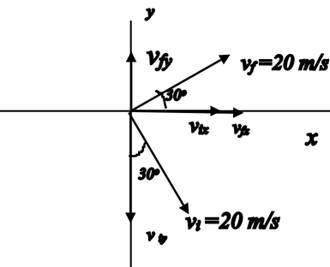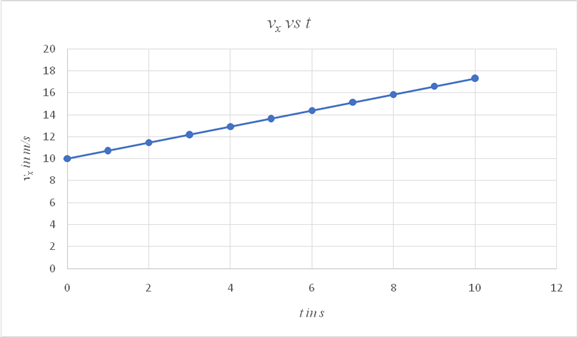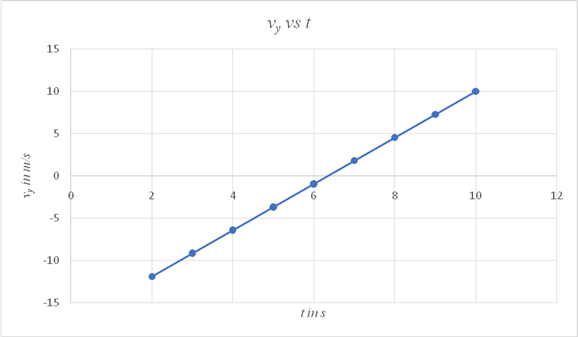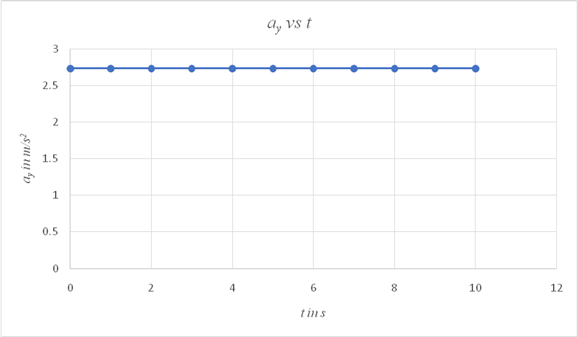
Concept explainers
(i) The x component of the velocity versus time
(ii) The y component of the velocity versus time
(iii) The y component of the acceleration versus time.
Explanation of Solution
Given info:
Magnitude of the initial velocity
Angle made by vi with x- axis
Magnitude of the final velocity
Angle made by vf with x axis
Time interval during which the velocity changes
Formula used:
The components of the velocity vectors along the x and the y directions are given by,
The change in velocity along the x and the y directions is given by,
The components of the acceleration along the x and y directions are given by,
The equation to determine the variation of
The equation to determine the variation of
Calculation:
Resolve the vectors vi and vf along the x and the y axes. This is shown in the diagram below.

The components of the velocity vector vi are directed along +x and-y axes, hence the y component is assigned a negative sign. Calculate the magnitude of the components substituting the values of the variables in the equation,
The components of the final velocity vector vf are directed along the +x and +y directions, hence the components are positive. Calculate the magnitude of the components of the vector vf using the values of the variables.
Calculate the change in velocity along the x and the y directions.
Calculate the components of the acceleration along the x and the y directions.
Using the values of vix and ax in the equation
Plot a graph showing the variation of vx with time.
| t in s | vxin m/s |
| 0 | 10 |
| 1 | 10.732 |
| 2 | 11.464 |
| 3 | 12.196 |
| 4 | 12.928 |
| 5 | 13.66 |
| 6 | 14.392 |
| 7 | 15.124 |
| 8 | 15.856 |
| 9 | 16.588 |
| 10 | 17.32 |

Using the values of viy and ay in the equation
Use the equation in a spread sheet and plot the graph showing the variation of vy with time t.
| X-Values | Y-Values |
| 0 | -17.32 |
| 1 | -14.588 |
| 2 | -11.856 |
| 3 | -9.124 |
| 4 | -6.392 |
| 5 | -3.66 |
| 6 | -0.928 |
| 7 | 1.804 |
| 8 | 4.536 |
| 9 | 7.268 |
| 10 | 10 |

The y component of the acceleration ay is independent of time, since the object's acceleration remains constant during the time interval.
Plot a graph showing the variation of ay with time t.
| t in s | ayin m/s2 |
| 0 | 2.732 |
| 1 | 2.732 |
| 2 | 2.732 |
| 3 | 2.732 |
| 4 | 2.732 |
| 5 | 2.732 |
| 6 | 2.732 |
| 7 | 2.732 |
| 8 | 2.732 |
| 9 | 2.732 |
| 10 | 2.732 |

Conclusion:
The graph showing the variation of vx with time is linear and the value increases from 10 m/s to 17.32 m/s at the end of 10 s.
The graph showing the variation of vy with time is also linear and its value increases from -17.32 m/s to reach a value of 10 m/s at the end of 10 s.
The graph showing the variation of ay with time is a straight line parallel to the time axis, showing that its value is invariant with time.
Thus all the results are consistent with an object moving with a constant acceleration during the time interval of 10s.
Want to see more full solutions like this?
Chapter 3 Solutions
COLLEGE PHYSICS
- The rectangular loop of wire shown in the figure (Figure 1) has a mass of 0.18 g per centimeter of length and is pivoted about side ab on a frictionless axis. The current in the wire is 8.5 A in the direction shown. Find the magnitude of the magnetic field parallel to the y-axis that will cause the loop to swing up until its plane makes an angle of 30.0 ∘ with the yz-plane. Find the direction of the magnetic field parallel to the y-axis that will cause the loop to swing up until its plane makes an angle of 30.0 ∘ with the yz-plane.arrow_forwardA particle with a charge of − 5.20 nC is moving in a uniform magnetic field of (B→=−( 1.22 T )k^. The magnetic force on the particle is measured to be (F→=−( 3.50×10−7 N )i^+( 7.60×10−7 N )j^. Calculate the y and z component of the velocity of the particle.arrow_forwardneed answer asap please thank youarrow_forward
- 3. a. Determine the potential difference between points A and B. b. Why does point A have a higher potential energy? Q = +1.0 C 3.2 cm 4.8 cm Aarrow_forwardPls help ASAParrow_forward1. Explain the difference between electrical field, potential difference, and electrical potential differencearrow_forward
- Pls help ASAParrow_forward9. When an electron moves into a uniform and perpendicular magnetic field, it will.. a. Accelerate parallel to the magnetic Field until it leaves b. Accelerate in a circular path c. Accelerate perpendicular to both the magnetic field and its original direction d. Repel back into the electric field 10. If a proton at rest is placed in a uniform magnetic field with no electric or gravitational field around, the proton will…….. a. Accelerate in the direction of the magnetic field b. Accelerate in a direction perpendicular to the magnetic field c. Move in a circular path d. Not acceleratearrow_forward7. The electric field at a distance of 1.0 mfrom a charged sphere is 100 N/C. At what distance from thesphere will the electric field be 50 N/C? a. 1.1 m b. 1.4 m c. 2.0 m d. 4.0 m 8. The electric potential due to a point charge at a point depends on a. The direction of the electric field b. The distance from the point charge c. The velocity of the point charge d. The mass of the point chargearrow_forward
 University Physics Volume 1PhysicsISBN:9781938168277Author:William Moebs, Samuel J. Ling, Jeff SannyPublisher:OpenStax - Rice University
University Physics Volume 1PhysicsISBN:9781938168277Author:William Moebs, Samuel J. Ling, Jeff SannyPublisher:OpenStax - Rice University Principles of Physics: A Calculus-Based TextPhysicsISBN:9781133104261Author:Raymond A. Serway, John W. JewettPublisher:Cengage Learning
Principles of Physics: A Calculus-Based TextPhysicsISBN:9781133104261Author:Raymond A. Serway, John W. JewettPublisher:Cengage Learning College PhysicsPhysicsISBN:9781938168000Author:Paul Peter Urone, Roger HinrichsPublisher:OpenStax College
College PhysicsPhysicsISBN:9781938168000Author:Paul Peter Urone, Roger HinrichsPublisher:OpenStax College Physics for Scientists and Engineers: Foundations...PhysicsISBN:9781133939146Author:Katz, Debora M.Publisher:Cengage Learning
Physics for Scientists and Engineers: Foundations...PhysicsISBN:9781133939146Author:Katz, Debora M.Publisher:Cengage Learning Physics for Scientists and Engineers, Technology ...PhysicsISBN:9781305116399Author:Raymond A. Serway, John W. JewettPublisher:Cengage Learning
Physics for Scientists and Engineers, Technology ...PhysicsISBN:9781305116399Author:Raymond A. Serway, John W. JewettPublisher:Cengage Learning Glencoe Physics: Principles and Problems, Student...PhysicsISBN:9780078807213Author:Paul W. ZitzewitzPublisher:Glencoe/McGraw-Hill
Glencoe Physics: Principles and Problems, Student...PhysicsISBN:9780078807213Author:Paul W. ZitzewitzPublisher:Glencoe/McGraw-Hill





